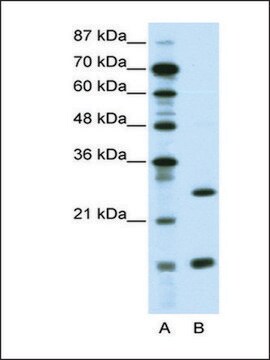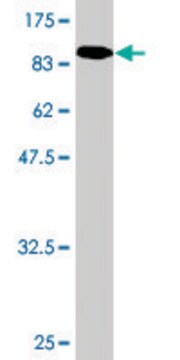MABE1018
Anti-BBF2H7/CREB3L2 Antibody, clone 28G9
clone 28G9, from mouse
Synonyme(s) :
Cyclic AMP-responsive element-binding protein 3-like protein 2, BBF2H7, cAMP-responsive element-binding protein 3-like protein 2/CREB3L2
About This Item
Produits recommandés
Source biologique
mouse
Niveau de qualité
Forme d'anticorps
purified antibody
Type de produit anticorps
primary antibodies
Clone
28G9, monoclonal
Espèces réactives
mouse, rat, human
Technique(s)
immunocytochemistry: suitable
immunoprecipitation (IP): suitable
western blot: suitable
Isotype
IgG1κ
Numéro d'accès NCBI
Numéro d'accès UniProt
Conditions d'expédition
wet ice
Modification post-traductionnelle de la cible
unmodified
Informations sur le gène
human ... CREB3L2(64764)
Description générale
Immunogène
Application
Epigenetics & Nuclear Function
Nuclear Receptors
Immunoprecipitation: A representative lot co-immunoprecipitated ER-associated E3 Ub ligase Hrd1 with BBF2H7/CREB3L2 from rat C6 glioma cells only before, but not after, ER stress induction by thapsigargin treatment (Kondo, S., et al. (2012). Cell Death Differ. 19(12):1939-1949).
Western Blottting Analysis: A representative lot detected BBF2H7/CREB3L2 upregulation in murine ATDC5 chondrogenic cells after siRNA-mediated Hrd1 knockdown, as well as BBF2H7/CREB3L2 upregulation in HeLa cells upon proteasome inhibition or ER stress induction (Kondo, S., et al. (2012). Cell Death Differ. 19(12):1939-1949.)
Immunocytochemistry: A representative lot detected enhanced ER & nuclear BBF2H7/CREB3L2 immunoreactivity in rat glioma C6 cells upon proteasome inhibitor MG132 treatment (Kondo, S., et al. (2012). Cell Death Differ. 19(12):1939-1949).
Qualité
Western Blotting Analysis: 0.25 µg/mL of this antibody detected BBF2H7/CREB3L2 in 10 µg of rat C6 glioma cell lysate.
Description de la cible
Forme physique
Stockage et stabilité
Autres remarques
Clause de non-responsabilité
Vous ne trouvez pas le bon produit ?
Essayez notre Outil de sélection de produits.
Code de la classe de stockage
12 - Non Combustible Liquids
Classe de danger pour l'eau (WGK)
WGK 1
Point d'éclair (°F)
Not applicable
Point d'éclair (°C)
Not applicable
Certificats d'analyse (COA)
Recherchez un Certificats d'analyse (COA) en saisissant le numéro de lot du produit. Les numéros de lot figurent sur l'étiquette du produit après les mots "Lot" ou "Batch".
Déjà en possession de ce produit ?
Retrouvez la documentation relative aux produits que vous avez récemment achetés dans la Bibliothèque de documents.
Notre équipe de scientifiques dispose d'une expérience dans tous les secteurs de la recherche, notamment en sciences de la vie, science des matériaux, synthèse chimique, chromatographie, analyse et dans de nombreux autres domaines..
Contacter notre Service technique








